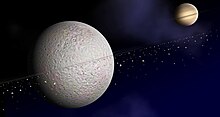User:Drbogdan/sandbox-Moonmoon
ALSO SEE => SUBPAGES
The original earlier "Moonmoon" article (see copy below) has since been redirected to the "Subsatellite" article. Drbogdan (talk) 20:17, 11 October 2018 (UTC)
---
A Moonmoon (also known as a moon moon, moon-moon, moonito, moonette, moooon or submoon) is a natural satellite that orbits a moon or an exomoon.[1][2][3][4][5][6]

It is inferred from the empirical study of natural satellites in the Solar System that moonmoons may be elements of planetary systems. The majority of detected exoplanets are giant planets, and some, like Kepler-1625b, has been shown to contain a large exomoon, named Kepler-1625b I.[3][7][8][9][10][11] In the Solar System, the giant planets have large collections of natural satellites (see Moons of Jupiter, Moons of Saturn, Moons of Uranus and Moons of Neptune). Therefore, it is reasonable to assume that moonmoons may exist in the Solar System, and in planetary systems beyond the Solar System.
Nonethess, no "moons of moons" or subsatellites (natural satellites that orbit a natural satellite of a planet) are currently known as of 2024[update] in the Solar System, or beyond the Solar System. In most cases, the tidal effects of the planet would make such a system unstable.
However, calculations performed after the recent detection[12] of a possible ring system around Saturn's moon Rhea indicate that satellites orbiting Rhea could have stable orbits. Furthermore, the suspected rings are thought to be narrow,[13] a phenomenon normally associated with shepherd moons. However, targeted images taken by the Cassini spacecraft failed to detect rings around Rhea.[14] It has also been proposed that Saturn's moon Iapetus had a satellite in the past; this is one of several hypotheses that have been put forward to account for its equatorial ridge.[15]
See also
[edit]References
[edit]- ^ Starr, Michelle (11 October 2018). "You'll Never Guess What Scientists Want to Call The Moon of a Moon - Can moons even have moons?". ScienceAlert.com. Retrieved 11 October 2018.
- ^ Kollmeier, Juna A.; Raymond, Sean N. (8 October 2018). "Can moons have moons?". Monthly Notices of the Royal Astronomical Society: Letters. 483: L80–L84. arXiv:1810.03304v1. doi:10.1093/mnrasl/sly219.
{{cite journal}}: CS1 maint: unflagged free DOI (link) - ^ a b Forgan, Duncan (4 October 2018). "The habitable zone for Earthlike exomoons orbiting Kepler-1625b". arXiv:1810.02712v1 [astro-ph.EP].
- ^ Crane, Leah (10 October 2018). "Moons can have moons and they are called moonmoons". New Scientist. Retrieved 11 October 2018.
- ^ Frost, Natasha (10 October 2018). "Guess what scientists call the moons of moons". Quatrz. Retrieved 11 October 2018.
- ^ Chong, Zoey (11 October 2018). "No one's ever seen a moonmoon, but the internet already loves it - Let the memes begin". CNET. Retrieved 11 October 2018.
- ^ Chou, Felcia; Villard, Ray; Hawkes, Alison; rown, Katherine (3 October 2018). "Astronomers Find First Evidence of Possible Moon Outside Our Solar System". NASA. Retrieved 11 October 2018.
- ^ Teachey, Alex; Kipping, David M. (3 October 2018). "Evidence for a large exomoon orbiting Kepler-1625b". Science. 4 (10): eaav1784. doi:10.1126/sciadv.aav1784. PMC 6170104. PMID 30306135.
- ^ "The Extrasolar Planet Encyclopaedia — Kepler-1625 b I".
- ^ Drake, Nadia (3 October 2018). "Weird giant may be the first known alien moon - Evidence is mounting that a world the size of Neptune could be orbiting a giant planet far, far away". National Geographic Society. Retrieved 11 October 2018.
- ^ "Hubble finds compelling evidence for a moon outside the Solar System - Neptune-sized moon orbits Jupiter-sized planet". SpaceTelescope.org. Retrieved 11 October 2018.
- ^ G. H. Jones, E. Roussos, N. Krupp, U. Beckmann, A. J. Coates, F. Crar, I. Dandouras, V. Dikarev & M. K. Dougherty, P. Garnier, C. J. Hansen, A. R. Hendrix, G. B. Hospodarsky, R. E. Johnson, S. Kempf, K. K. Khurana, S. M. Krimigis, H. Krüger, W. S. Kurth, A. Lagg, H. J. McAndrews, D. G. Mitchell, C. Paranicas, F. Postberg, C. T. Russell, J. Saur, M. Seiß, F. Spahn, R. Srama, D. F. Strobel, R. Tokar, J.-E. Wahlund, R. J. Wilson, J. Woch, D. Young (7 March 2008). "The Dust Halo of Saturn's Largest Icy Moon, Rhea – Jones et al. 319 (5868): 1380 – Science". Science. 319 (5868): 1380–1384. Bibcode:2008Sci...319.1380J. doi:10.1126/science.1151524. PMID 18323452. S2CID 206509814. Retrieved 11 October 2018.
{{cite journal}}: CS1 maint: multiple names: authors list (link) Pdf - ^ Jeff Hecht. "Saturn satellite reveals first moon rings – 06 March 2008 – New Scientist". Retrieved 11 October 2018.
- ^ Tiscareno, Matthew S.; Burns, Joseph A.; Cuzzi, Jeffrey N.; Hedman, Matthew M. (2010). "Cassini imaging search rules out rings around Rhea – Tiscareno – 2010 – Geophysical Research Letters – Wiley Online Library". Geophysical Research Letters. 37 (14): L14205. arXiv:1008.1764. Bibcode:2010GeoRL..3714205T. doi:10.1029/2010GL043663. S2CID 59458559.
- ^ "How Iapetus, Saturn's outermost moon, got its ridge". 13 December 2010. Retrieved 11 October 2018.
External links
[edit]![]() Media related to Extrasolar moons at Wikimedia Commons
Media related to Extrasolar moons at Wikimedia Commons
- Shadow Moons: The Unknown Sub-Worlds that Might Harbor Life
- Likely First Photo of Planet Beyond the Solar System
- Working Group on Extrasolar Planets – Definition of a "Planet" Position statement on the definition of a planet. (IAU)
- The Hunt for Exomoons with Kepler (HEK): I. Description of a New Observational Project



